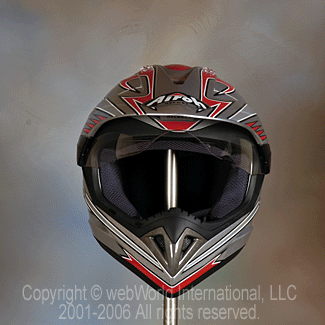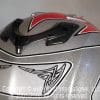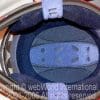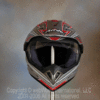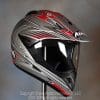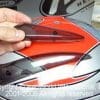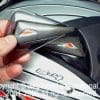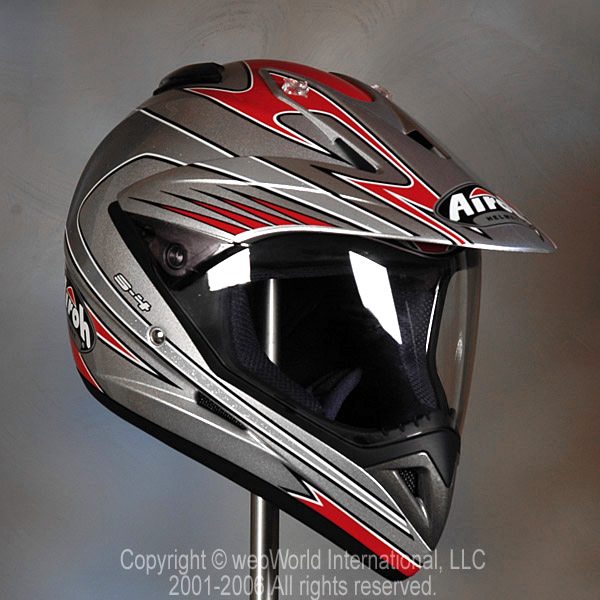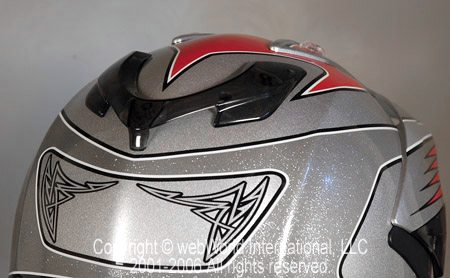Airoh S4 Motorcycle Helmet
Our recent review of the Arai XD “Enduro” styled helmet has generated a lot of interest from webBikeWorld visitors.
I hadn’t thought much about the article after it was posted.
To be honest, I figured the XD was a quirky helmet that wouldn’t really be setting any design trends.
I haven’t to this day seen another rider wearing one in anything other than in a photograph.
But several emails regarding the XD were sent by some adventure touring fanatics who taught us a couple of things.
The street/enduro helmet style has plenty of fans and we were mistaken in thinking that Arai was the only company pursuing this design.
So after being sent back to school on this subject, we discovered the Airoh S4.
The Airoh helmet first attracted us with its good looks and its extremely light weight, but it has much more, as I discovered quite by accident (more later).
I originally planned on evaluating the S4 as a competitor to the Arai XD, and so it went, until I discovered the S4’s special secret. And a very interesting secret it is, as you shall see!
Airoh Helmets are popular in Europe but the Italian company is not well known in the United States.
Airoh makes a huge variety of motorcycle helmets of all different types: full-face, open-face, modular, flip-up, enduro, motocross, trials and more.
They even have a line of motorcycle helmets for children in a variety of helmet types from size XXXS to S (50 to 56 cm).
Airoh is known for very interesting and unique designs that have that wonderful Italian flair for style. Their helmets are actually made in Italy, rather than in some offshore plant and they are constructed to meet ECE 22.05 safety approval and above (our S4 is also ACU Gold approved).
I don’t know if Airoh is planning on distributing their helmets in the U.S.A., but the helmets can easily be purchased online from the UK or other countries and shipped to the U.S. very quickly.
All it takes is getting used to parting with your weak greenbacks, which makes the exorbitant shipping fees seem rather brutal.
We purchase many items from the UK for various webBikeWorld reviews and they typically arrive here on the East Coast faster than many of the items purchased from California or even the rest of the U.S.A.
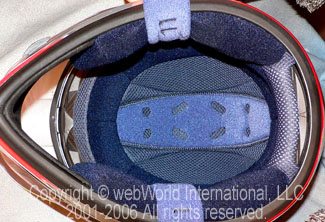
Fit and Finish
Our Airoh S4 is very nicely finished. It may not have the quality of, for example, a Shark RSi but I’d compare it to something in the neighborhood of an HJC CL-14, our 2005 Helmet of the Year, which is very good company indeed, in case you’re wondering.
I have no experience with the high-end Airoh helmets, like their Dragon F1, which uses a fiberglass/Kevlar composite shell, so I don’t have anything to compare regarding the quality of their products overall.
I think the graphics and paint on the S4 are probably a bit uninspired in their style, but the paint is applied with high quality without any overspray, orange peel or dust specks and it has a good appearance.
It’s hard to see in the photos, but there’s lots of twinkly metalflake painted sections here and there on the S4 and the overall pattern suits the helmet’s shape.
The helmet has a nice, thick clearcoat applied over the graphics and decals, which should help to keep it looking good for some time.
Many of Airoh’s helmets are made from thermoplastic, which may or may not be a bad thing, depending upon how you view the controversy started by Motorcyclist magazine regarding helmet shell testing (see the wBW Motorcycle Helmet FAQ page for more information).
Thermoplastic is sometimes an indicator of a “cheap” helmet, but all of the pieces on our S4 fit perfectly together and they are lined up with very close tolerances.
The S4 is actually very reasonably priced, listing at �129.99 (about $240.00), which is a relative bargain if you don’t take into account the weak dollar. So my overall feeling is that the Airoh S4 is very nicely done, especially considering the price.
I’d say that the S4 has a sort of “egg shaped” internal fit; that is, it’s round up top and slightly tight along the sides on the rider’s cheeks (see the wBW Motorcycle Helmet FAQ page for more information on helmet shapes).
I have a round head and the Arai Quantum II, for example, fits me very well. I’d say that the Airoh S4 fits like the Quantum II or the Shoei RF-1000 up top and something like a Shoei X-11 along the sides.
The S4 is very comfortable with a typical but not outstanding liner that feels relatively well padded. The liner and cheek pads are removable and washable and Airoh says the liner used Coolmax fabric for moisture transfer away from the skin. The liner is also treated with some type of anti-bacterial product.
Airoh S4 Ventilation
Maybe part of the S4’s low price is due to its simplicity; the helmet has no movable vents. This isn’t as bad as it sounds, because our feeling after reviewing many different helmets is that vent design, for the most part, is atrocious.
Most vents offer added complexity and added noise without much in return.
The Airoh S4 has a permanently open exhaust diffuser out back that works as a sort of Venturi vent/exhaust system.
Air is pushed through the front of the diffuser and exhausted out the back (rear view shown below), and I guess it’s supposed to pull air up through the holes in the shell and exhaust it out the back, under the diffuser.
I have no idea if this works, just as I have no idea if any rear exhaust system works on any other helmet I’ve ever tried.
Although I did have the opportunity to wear an Arai Profile (review coming soon) directly after wearing the S4 and I definitely noticed the ventilation through the top of the Profile when compared to the S4.
The S4 also has a permanently open chin vent, but the enduro-style helmets typically get lots of air coming up from under their extended chin bars anyway, so it’s hard to tell whether the chin vent is adding to the mix.
Noise Levels
Here’s where the S4 really surprises. On unfaired bikes, the S4 is, believe it or not, one of the quietest helmets I’ve tried.
Although this may not be as surprising as it sounds, because we’ve been ranting for years about the noise created by vents and other appendages on motorcycle helmets, and this helps prove our point that most vents cause noise.
Air rushing over a vent holes can cause the “Coke bottle” whistling effect, which can be extremely annoying, as we found on the Arai XD. The Airoh S4’s lack of front or top opening vents eliminates this cause of helmet noise.
We did find though that the S4 can be noisy behind some types of half-fairings that dump air on the lower part of the helmet. The turbulent air causes some lower frequency noises from around the neck area of the helmet. Even so, we’ve tried many full-face helmets that are much noisier. So I give the S4 high marks for noise control.
Remember that we always wear correctly fitted earplugs when riding (See the wBW Earplugs and Hearing Protection page) and a helmet liner, so your experience may be different.
We’re not sure if these sound files of helmet noise have been useful, as we haven’t received many comments about them. In any case, we recorded an MP3 sound file of the Airoh S4 made while riding with the helmet from 0 to 60 MPH.
For comparison, more sound files can be found on the wBW Motorcycle Helmet Noise page.
Airoh S4 Face Shield
The S4’s clear face shield is very wide and nice and tall, which provides a very good view of the road. I have to really turn my eyes from side to side or up and down to see any part of the helmet or liner, it’s that wide. Between the very light weight (see below) and the big, wide face shield, it’s almost like there’s no helmet between me and the road, which is a real joy.
It’s been a while since I’ve worn a helmet with such good visibility, and I forgot what a difference this can make while riding. I feel like I can see so much better and it gives me a much more secure feeling of control. I may be dreaming but I feel like I can ride faster and certainly more confidently when wearing this helmet.
The downside of the face shield is that it doesn’t raise all the way out of my sight due to the enduro style sun visor on top of the helmet.
This isn’t really much of a problem, because the face shield is closed when riding, but it was a bit disconcerting the first couple of times I tried lifting it.
Also, the face shield feels slightly flimsy and the finger tab is off to one side, forcing the visor to twist as it’s opened or closed.
Airoh uses a friction system to hold the shield open, which then prevents it from snapping shut, so the shield must be pushed into place until it seals against the very wide full-length gasket around the eye opening.
This gasket actually forms the eye port and is a very nice design feature that allows a good seal between the visor and the helmet. When the face shield is closed against the gasket, the gasket material then fills in the gap between the visor and the helmet shell, which helps prevent any air or noise from that area.
I think the clear plastic visor material also has some very slight distortion compared to others. But in the end, the huge panoramic view afforded by the design of the helmet makes the faults seem minor.
Helmet Weight
Our size XL Airoh S4 weighs in at a feathery 3 lbs., 3 oz. (1445 grams), a full 8 ounces lighter than the Arai XD. This makes the Airoh one of the most lightweight helmets we’ve ever tried. See the wBW Motorcycle Helmet Weights page for a chart that compares the weights of all of the helmets we’ve reviewed.
The S4 Surprise Feature
As we mentioned above, the Airoh S4 has a secret surprise. After using the helmet for nearly two weeks, I sat down to write this review and as I neared the end of my task I realized I didn’t know how to remove the visor.
I pulled out the owner’s manual for the first time (there’s a lesson here, kids) to learn more, and that’s when I discovered that the S4 is actually a three-for-one deal.
Besides being a great-looking enduro style helmet, the S4 can be converted into a motocross helmet by leaving the sun visor on top while removing the clear visor.
Now that may not seem like much of a trick, but get this: the S4’s sun visor and side plates can be removed and replaced with a couple of snap-in trim pieces (provided with the helmet), which turn the S4 into a pretty cool-looking (devilish-looking, actually) street helmet:
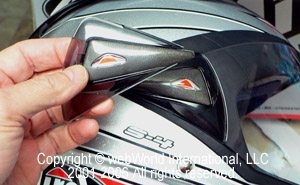
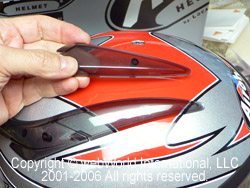
Notice the side plates that hold the visor and the top strakes that snap into the holes where the sun visor used to be? The conversion is fairly straightforward if attention is paid to the directions and tiny photos in the owner’s manual.
The male plastic plugs that snap into the helmet are rather delicate, so it takes some patience to get everything correctly lined up, but with practice, the conversion can be finished in maybe 5 minutes or so.
Airoh supplies a bag full of the conversion parts in the box with the helmet. I’ll have to admit that I saw the bag of parts when I first pulled the helmet out of the box, but I didn’t really pay much attention, because many helmets come with extra goodies that I rarely find a use for.
I went back to the Airoh website and could not find any information on converting the S4, nor was there any information on the website of the UK retailer where we purchased the helmet, so let’s just say it’s Airoh’s little secret.
Other Features
The S4 uses a “quick release” (an oxymoron) chin strap fastener. I don’t like these devices because they seem too complicated and they don’t have the infinite adjustment of a D-ring system.
That is, they have to be adjusted once through trial and error, where a D-ring can be adjusted instantly whenever necessary.
The combination of the “quick release” lever and the chin strap on the S4 cuts in to my neck just above my prominentia laryngea (Adam’s Apple, or thyroid cartilage).
Conclusion
The Airoh S4 is an interesting and unique helmet that offers a lower-priced alternative to the Arai XD. It’s very light weight and very quiet in most instances and its unique ability to be converted to a cool-looking street helmet is a plus.
Note that the Airoh S4 is not DOT FMVSS 218 but meets ECE 22.05 standards and also carries a British ACU Gold sticker, which is necessary for racing use.
| wBW Review: Airoh S4 Motorcycle Helmet | |
|---|---|
| Available From: Airoh | List Price (2006): £129.99 (about $240.00) |
| Colors: Red and Blue graphics. Black and Dark Grey. | Made In: Italy |
| Review Date: May 2006 | |
Owner Comments and Feedback
See details on submitting comments.
From “J”: “First of all, let me congratulate WebBikeWorld for giving consistent reviews on motorcycle helmets.
Recently I purchased an Airoh S4 Enduro helmet, your review on the helmet was pretty spot-on.
Firstly, the shape comment was correct, although I don’t exactly know my head shape, I did feel tightness on the sides of my head and putting the helmet on is tight when initially pushing it past the temples downwards (proper helmet wearing guides were followed, as per the instructions that came with the helmet).
Measurements were done correctly and in fact I have another helmet of the size (medium) which fits fine. So I guess the internal shape of the helmet is more of an ‘Egg’ type shape as per your review.
Although the rubber lining around the visor area is large, I found that the lower side parts (near the cheeks) did not close up nicely, so the rubber and visor does not actually touch, thus gaps are present (on both sides) and not sealed, which would result in wind noise when riding.
A simple test by using hand/finger to block the side parts where visor and rubber meets immediately causes the wind noise to be dramatically lesser. I tested this 1 side at the time with noticeably difference in wind noise level on the side which has been covered.
Where I live, the weather is HOT, and the vents don’t really provide much relief and air flow from the nose (front part) is not that apparent, when it is cold and rainy, I try to breathe slowly or blow my breath downwards so that the visor doesn’t fog up.
Mine is a matt black finish and the one thing I just don’t understand is:
Why in the world did they use white lining for the interior of the *%$# helmet?! It’s not about color coordinating, more importantly, the white lining used actually gets somewhat reflected onto the visor (something like seeing your reflection on a glass, not mirror; You can’t really see it, but you can see that there’s something on the visor.
It is extremely irritating because I keep thinking that the visor is either dirty/scratched or makes me lose focus especially when heavy traffic because your eyes are constantly darting here and there making sure the road ahead is clear and vehicles around you are not too close to you!
I wouldn’t be surprised if it causes dizziness. This is why I really think that linings should be dark colored so they don’t reflect on your visor!
Though it may seem like a lot of flaws for this helmet, you have to admit that the look/style is darn right cool.”
From “N.S.P.”: “Shoei marketed helmet with the name Hornet. According to the graphics on helmet, it has different names like Hornet, Hornet Admix, Hornet Glide, and Hornet Pulse.
The Hornet Sector I purchased in 2004 is now a discontinued color scheme. Unfortunately, the Shoei Hornet can�t be purchased in the USA.”
N.S.P. also sent us these links to the Japan-only enduro-styled helmets, the Arai “Tour Cross” and “TX Motard”, the Shoei “Hornet” (wBW review) and the Honda “JG2 Fang” helmet.


